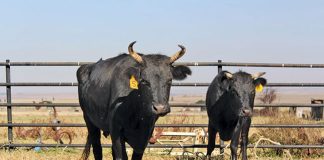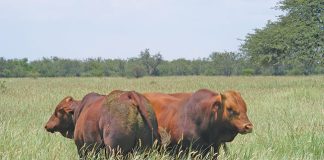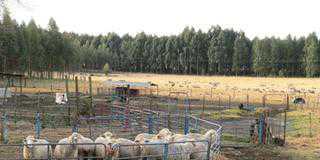The concept has already been years in the making, and finally Lesotho has begun implementing a countrywide livestock-marking programme to combat stock theft. South Africa is providing expertise and will benefit from the programme as well. Lloyd Phillips pays the mountain kingdom a visit.
In 2005, JOHAN CAMPHER OF ANIM-SCI Consultants was contraced by the Lesotho government to design a unique National Livestock Registration, Marking and Information System (LRMIS) to allow that country to trace animals and improve the management of its livestock. In a Farmer’s Weekly article (18 November 2005), Campher detailed how the system would work and what was hoped it would achieve. As with most governments, the wheels of bureaucracy turn slowly in Lesotho, and despite Campher’s system having met with widespread approval when explained to the mountain kingdom’s government some years ago, funding for the practical implementation of the system has only recently been forthcoming from Lesotho’s officials – and on a trial basis.
Tamolo Lekota is one of 10 district livestock registration managers covering all the administrative regions of Lesotho, with his area of operations being Quthing. His job is to manage all aspects of the LRMIS in his district, including the registration of animals and people involved in Quthing’s livestock sector, as well as to facilitate the training of governmental and civilian livestock marking operators. “In April 2006, the Registration and Marking Department (NLRMD) was allocated M8 million (1 maluti = 1 rand) to run a one-year fully operational practical implementation of in the three mountain districts of Mokhotlong, Qacha’s Nek and Thaba Tseka as a trial,” Tamolo says. “When the year is over, the results of this practical implementation will be presented to the Lesotho parliament for it to make a decision on whether or not to approve the estimated M100 million required for implementing the system in the remaining seven districts of Lesotho.”
Despite already having established computerised registration systems, livestock marking designs, and regional offices of the NLRMD in the three trial districts, it is not an easy task for officials to register and mark the minimum counted 128 347 cattle, 25 175 horses, 30 534 donkeys, 378 475 sheep, 223 861 goats and numerous other livestock species collectively in Mokhotlong, Qacha’s Nek and Thaba Tseka. In addition, the districts’ regional offices are also currently registering all livestock owners, herdsmen, babeisi (animal passport) writers, livestock industry representatives, traders and marking operators.
Official livestock markings have never existed in Lesotho, making it relatively easy for stock thieves to steal animals from fellow Basotho. Livestock owners resorted to using unofficial homemade brands and ear-notchings on their animals in an attempt to prove ownership, but these were often not sufficient to allow Lesotho police to effectively investigate and prove stock-theft cases. It was also difficult to get courts of law to take the unofficial markings into evidence. amolo explains, “Even if livestock stolen from South Africa by Basotho thieves was brought into Lesotho, these official South African brands meant very little to either honest citizens here or to the Lesotho police as there was no official local system in Lesotho to compare these brands to. ”People would tend to think they were homemade brands.
With our new official livestock marking system, citizens and authorities will now be able to recognise that a particular animal does not belong in an area and they will be able to notify the police. South Africans will also be able to identify animals stolen from Lesotho and taken into South Africa,” says Tamolo. ”This to-and-fro stock theft between the two countries happens more frequently than one might think.” System challenges Despite the practical trial of the LRMIS having been launched already, Tamolo and his fellow DLRMs acknowledge there are some aspects of the system that are still in the experimental stages. By trying out various methods of these aspects, the NLRMD hopes to find options that work best for them.
One aspect is livestock marking techniques. The KwaZulu-Natal Red Meat Producers’ Organisation (KZN RPO) and the KZN Agriculture Union’s (Kwanalu’s) security desk have long been concerned with cross-border stock theft between the province and Lesotho. To this end, KZN RPO manager Jaco Rossouw and the Kwanalu security desk’s Koos Marais have participated in meetings between KZN and Lesotho farmers and security officials, and have facilitated the sourcing of livestock marking expertise from KZN for the NLRMD. SA-registered livestock marking operator Bruce Mattisson of Howick, KZN, was recently approached by Jaco and Koos to train NLRMD officials and prospective Basotho livestock marking operators in hot-branding cattle, horses and donkeys, and tattoo-marking sheep and goats. Bruce is the third livestock marking expert from SA contracted by the Lesotho government to offer training to its people. According to Tamolo, with each expert having his own technique for livestock marking, Lesotho officials will be taking ideas that work best under the country’s conditions from each expert. “We are looking at the practicalities of the different equipment needed to mark animals,” says Tamolo. “We are going to mark animals in very rural areas, so we need equipment that mostly does not need electricity, is durable, and easily transportable by vehicle and hand. Battery- operated animal immobilisers must be rechargeable using vehicle batteries.” Thaba Tseka DLRM Motselisi Kaeane says livestock owners across Lesotho are being sensitised to the Stock Theft Act of 2000, which requires them to register themselves and their animals with the NLRMD, and to mark their animals with officially allocated markings. “We are having registration and marking days across the three districts where we use laptop computers to record all the data. We then download these data onto the government mainframe where the information is then available to all relevant authorities,” Motselisi explains.
There have been the typical hiccups with getting the LRMIS fully up and running. Tamolo and Motselisi both agree that government bureaucracy is hindering the speedy implementation of the system, particularly when they try to requisition equipment. Office space and equipment for the NLRMD is still in short supply, and there have been software glitches with the LRMIS computer system. However, the two DLRMs are positive that things will sort themselves out and that they will be contributing to reducing the scourge of stock-theft in their country. Both are finding it easy to get out into rural areas to gather registrations and to issue livestock markings, and say livestock owners are optimistic that the system will reduce the rampant theft of their animals. “The police also realise the value of the system and are working closely with us,“ say Tamolo and Motselisi. “With this system we hope to restore our livestock owners’ ability to depend on their animals for income generation, food supply and draught power.
Many people don’t realise it, but reduced stock theft in our country will contribute in many ways to poverty alleviation.” Meanwhile, Bruce, Jaco and Koos are looking forward to the positive impact the LRMIS will have on stock theft from KZN into Lesotho. If Lesotho’s officials and livestock owners carry out their paperwork and livestock marking properly, it should make it far more difficult for SA livestock to be sneaked into Lesotho and vice versa. It should also be easier to tell stolen animals from SA in Lesotho apart from that country’s animals. This will improve their recovery – provided that SA livestock owners also come to the party by properly branding and registering their own animals. Contact Johan Campher on 082 568 7893 or e-mail [email protected]; Tamolo Lekota on (00 266) 223 26025 or e-mail [email protected]; or Motselisi Kaeane on (00 266) 229 00161 or (00 266) 589 06373. |fw













